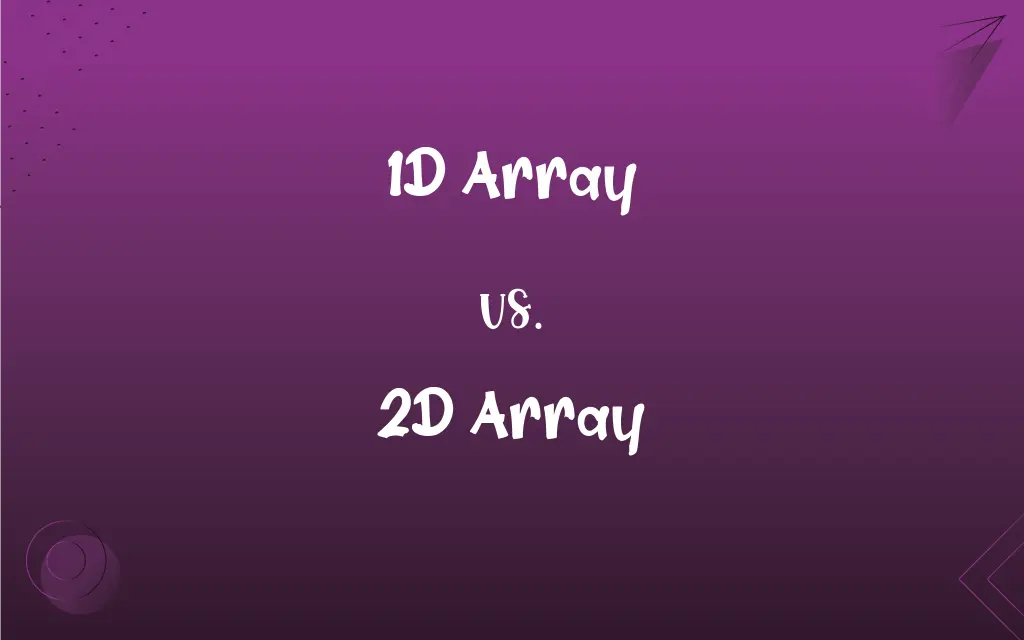1D Array vs. 2D Array: What's the Difference?
Edited by Aimie Carlson || By Harlon Moss || Published on February 22, 2024
A 1D array is a single row or column of elements, linear in nature, while a 2D array is a collection of rows and columns, forming a grid-like structure.

Key Differences
A 1D array, also known as a one-dimensional array, is a sequence of elements in a linear form, like a list. In contrast, a 2D array, or two-dimensional array, is like a matrix, consisting of rows and columns, allowing for more complex data representation. Both 1D and 2D arrays store elements in a structured manner, but the 2D array offers a grid-like layout as opposed to the linear form of the 1D array.
In terms of memory allocation, a 1D array occupies a contiguous block of memory with its elements stored in a single row or column. On the other hand, a 2D array is allocated memory in a tabular form, where each row may have its memory block, creating a grid of values. Both 1D and 2D arrays are efficient in their respective data handling, but the 2D array provides a more structured approach for multi-dimensional data compared to the flat nature of the 1D array.
When accessing elements, a 1D array requires only a single index to pinpoint a specific element. In contrast, accessing an element in a 2D array requires two indices, one for the row and one for the column. This difference highlights the simplicity of the 1D array and the complexity of the 2D array in terms of data manipulation and retrieval.
The 1D array is often used for simple lists of data where only one attribute is stored, such as a list of names or numbers. Conversely, a 2D array is ideal for scenarios requiring a more complex structure, like a spreadsheet or a chessboard, where data is organized in rows and columns. Both 1D and 2D arrays serve different purposes based on the complexity and structure of the data they are meant to handle.
In programming, the implementation of a 1D array is generally simpler and more straightforward than that of a 2D array. While the 1D array provides ease of use and understanding, the 2D array offers a more comprehensive approach for dealing with layered data, such as matrices or tables. Both 1D and 2D arrays are fundamental in data structure concepts, each serving unique roles in data storage and manipulation.
ADVERTISEMENT
Comparison Chart
Structure
Linear, single line of elements
Grid-like, with rows and columns
Memory Allocation
Contiguous memory in one dimension
Memory in rows and columns
Indexing
Single index to access elements
Two indices (row and column) for access
Use Cases
Suitable for simple lists
Ideal for complex structures like matrices
Implementation
Simpler and straightforward
More complex due to additional dimension
ADVERTISEMENT
1D Array and 2D Array Definitions
1D Array
A 1D array is a single row or column of data.
Student_grades = ['A', 'B', 'C', 'D'] is a 1D array of student grades.
2D Array
A 2D array is a matrix-like structure with rows and columns.
Matrix = [[1, 2, 3], [4, 5, 6]] represents a 2D array or matrix.
1D Array
A 1D array is a collection of elements accessed by a single index.
Days = ['Monday', 'Tuesday', 'Wednesday'] is a 1D array of weekdays.
2D Array
A 2D array is a collection of elements accessed by two indices.
Temperature_grid = [[72, 74], [68, 70]] is a 2D array of temperature readings.
1D Array
A 1D array is a single-dimensional vector.
Scores = [85, 90, 95, 88] represents a 1D array of scores.
2D Array
A 2D array is a table of elements with row and column indices.
Sales_data = [[200, 300], [400, 500]] forms a 2D array of sales figures.
1D Array
A 1D array is a list of items of the same type.
Colors = ['red', 'blue', 'green'] forms a 1D array of color names.
2D Array
A 2D array is a collection of 1D arrays aligned in rows and columns.
Chess_board = [['R', 'N'], ['P', 'P']] is a 2D array representing a part of a chessboard.
1D Array
A 1D array is a linear sequence of elements.
Temperatures = [67, 70, 74, 69] represents a 1D array of temperatures.
2D Array
A 2D array is a grid of items in two dimensions.
Seating_chart = [['Alice', 'Bob'], ['Carol', 'Dave']] is a 2D array showing a seating arrangement.
FAQs
Can 1D arrays store different data types?
Typically, 1D arrays store elements of the same data type.
What is a common use case for a 2D array?
A 2D array is often used for complex structures like spreadsheets or game boards.
How do you access elements in a 2D array?
Elements in a 2D array are accessed using two indices: one for the row and one for the column.
What is a common use case for a 1D array?
A 1D array is commonly used to store simple lists, such as names or numbers.
How is memory allocated for a 1D array?
Memory is allocated contiguously for a 1D array.
What is a 1D array?
A 1D array is a linear sequence of elements.
What is a 2D array?
A 2D array is a grid-like structure with rows and columns.
How do you access elements in a 1D array?
Elements in a 1D array are accessed using a single index.
How is memory allocated for a 2D array?
Memory for a 2D array is allocated in a tabular form, with separate blocks for rows and columns.
Can 2D arrays store different data types in different rows?
Generally, 2D arrays are used to store homogeneous data, but they can store different types per row depending on the programming language.
Do 2D arrays require more memory than 1D arrays?
Yes, 2D arrays may require more memory due to their complex structure.
How does the size of a 1D array affect its performance?
Larger 1D arrays may take longer to process, but their linear structure keeps operations relatively efficient.
Is it possible to have uneven lengths in rows of a 2D array?
Depending on the programming language, 2D arrays can have rows of varying lengths.
Are 1D arrays easier to implement than 2D arrays?
Yes, 1D arrays are generally simpler and more straightforward to implement.
Can a 1D array be converted to a 2D array?
Yes, a 1D array can be restructured into a 2D array by defining rows and columns.
Can you store a 2D array within a 1D array?
Conceptually, a 2D array can be represented within a 1D array, but its structure becomes linear.
Are there limitations to the number of elements in a 1D array?
The size of a 1D array is often limited by the system's memory and the programming language's constraints.
Are there limitations to the dimensions of a 2D array?
The dimensions of a 2D array are limited by system memory and the programming environment, but they are generally more flexible than 1D arrays.
How does the size of a 2D array affect its performance?
Larger 2D arrays can significantly impact performance due to increased complexity in accessing and manipulating data.
Can a 2D array be converted to a 1D array?
Yes, elements of a 2D array can be flattened into a 1D array.
About Author
Written by
Harlon MossHarlon is a seasoned quality moderator and accomplished content writer for Difference Wiki. An alumnus of the prestigious University of California, he earned his degree in Computer Science. Leveraging his academic background, Harlon brings a meticulous and informed perspective to his work, ensuring content accuracy and excellence.
Edited by
Aimie CarlsonAimie Carlson, holding a master's degree in English literature, is a fervent English language enthusiast. She lends her writing talents to Difference Wiki, a prominent website that specializes in comparisons, offering readers insightful analyses that both captivate and inform.




































































